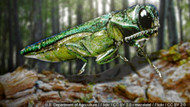Battling the Beetle
Posted by Alexandra Montgomery of www.wcax.com on Apr 29th 2018
CONCORD, N.H. (WCAX) It's a slow-moving disaster that experts say will eventually kill tens of millions of ash trees in Vermont. The emerald ash borer has hurt our neighbors in New Hampshire for years and experts there could help slow the spread. Our Alexandra Montgomery found good news and bad news, as crews "Battle the Beetle."
Choked by the emerald ash borer, the trees in this New Hampshire forest have finally given up.
"Really starting to see that heavy die-off," said Bill Davidson, a forest health specialist with the New Hampshire Division of Forests and Lands.
The invasive beetle first showed up in New Hampshire in Concord back in 2013. Davidson has been fighting it ever since. Most of the state is still in good shape but it's spread about 30 miles in each direction in five years.
"All things considered, that's slower than we would have expected and about as good as we hoped," Davidson said.
Eventually, Davidson says the bug will work its way across the state. In the meantime, his team is working to slow the spread.
In this forest, tiny, tiny stingless wasps-- or parasitoids-- that kill the emerald ash borer have been released. The wasp lays its own eggs into the eggs of the EAB.
"As the wasps complete their development, they'll fly out into the forest and search for more ash borer larvae to parasitize," Davison explained.
Even with an eager beetle killer, Davidson says these trees are still going to die because the wasps can't reproduce fast enough to match the EAB numbers. But the hope is that the next generation of ash trees years from now can survive.
"We're going to have the situation where the parasitoids are part of the environment and there's not as many large ash trees around to support that big outbreak level population of ash borers," Davidson said.
There has already been some success. A spokesperson for the USDA says wasps that attack the EAB larvae were able to kill up to 85 percent of the beetle population in southern Michigan and reduce the EAB's growth rate in young trees.
It's research that's very much ongoing.
About 100 ash trees were chopped down at the North Family Farm in Canterbury. All of them were infected by the emerald ash borer. Tim Meeh said there are not too many trees left for him to cut down.
"I don't want to say we're making it extinct but it's-- we're cutting it," Meeh said.
Meeh is a maple sugarer and firewood supplier. He sells more than just ash, but that's become the main tree on his chopping block.
"We're trying to get them before the branches get loose and get too dangerous to cut," Meeh said.
The tree enthusiast says he was surprised when the ash borer showed up on his property years ago.
"I didn't realize the extent of how bad it would be," he said.
One thing going for him-- there's a market for the wood.
"A nice ash log like that big one up there would be worth $800 to $1,000," Meeh said. "There's a strong demand; it's a nice, light-colored wood."
Selling infested wood does come with rules, though, since Meeh is in the heart of a quarantined county.
"Segregate our ash piles in the firewood and keep the ash deliveries really local," Meeh said.
Quarantine is a method that seems to have worked for New Hampshire and could work for Vermont.
"The biggest part of any success we've had is mostly our outreach program, so just engaging with community, letting people know what steps they can take to prevent spreading it more than it will spread on own," Davidson said.
It is a tree you may find right in your yard. A joint-government study says ash is a popular landscape tree and it was the most commonly planted tree to replace the elms decimated throughout North America by the Dutch elm disease.
It's not all bad news, though. Some trees are still thriving after being injected with an insecticide. It's an option Davidson says city leaders or Vermont homeowners may choose to save trees that are pretty or valuable. But depending on size, it can be pricey.
"Each tree can be about $100, reapplied every three years," Davidson said.
And he says it's not clear what treating an entire forest would do to the environment.
He says property owners should be thinking about whether to take steps to try to save their trees, cut them down or let nature take its course.
"Know what kind of trees on your property and have a plan so that you know once you become impacted, you're not blindsided," he advised.
Vermont state leaders say they'll be coming up with a management plan once they figure out how bad the infestation is. In the meantime, they don't want you to panic, as it will take years for the trees to die. And we're told there is some hope-- a small number of ash trees will be able to stand up to the ash borer all on their own.

